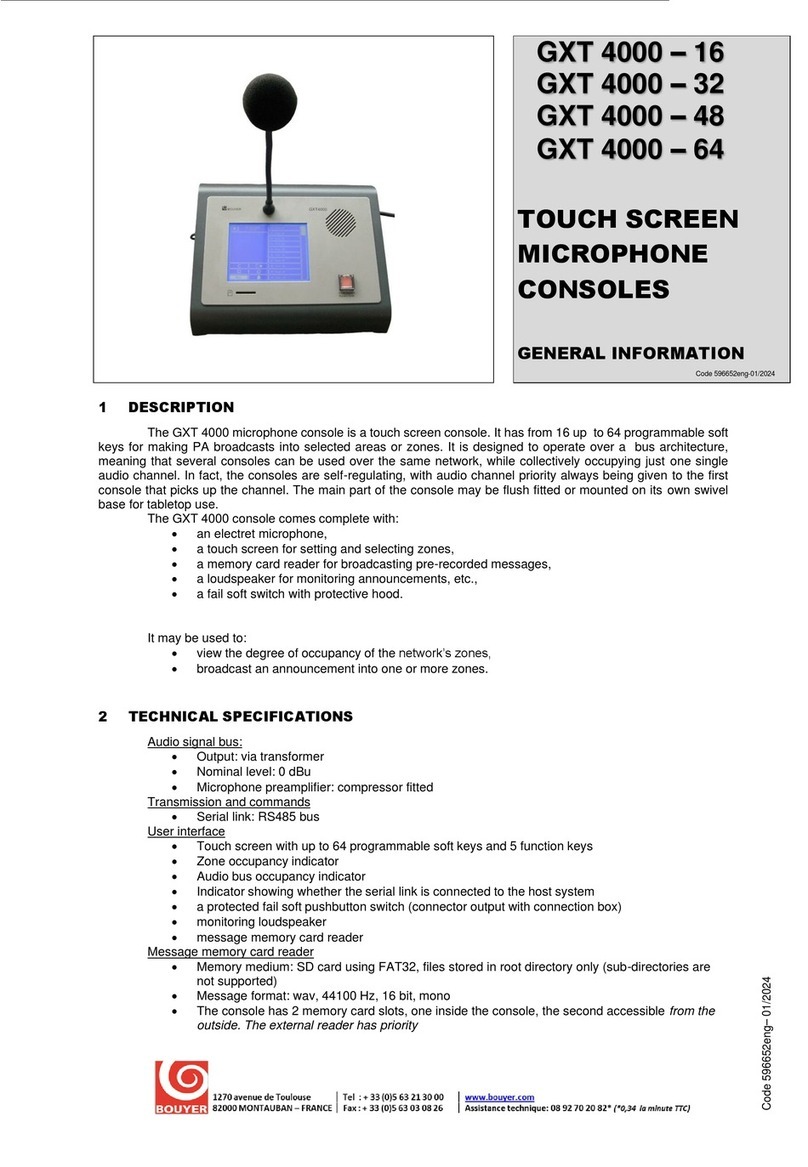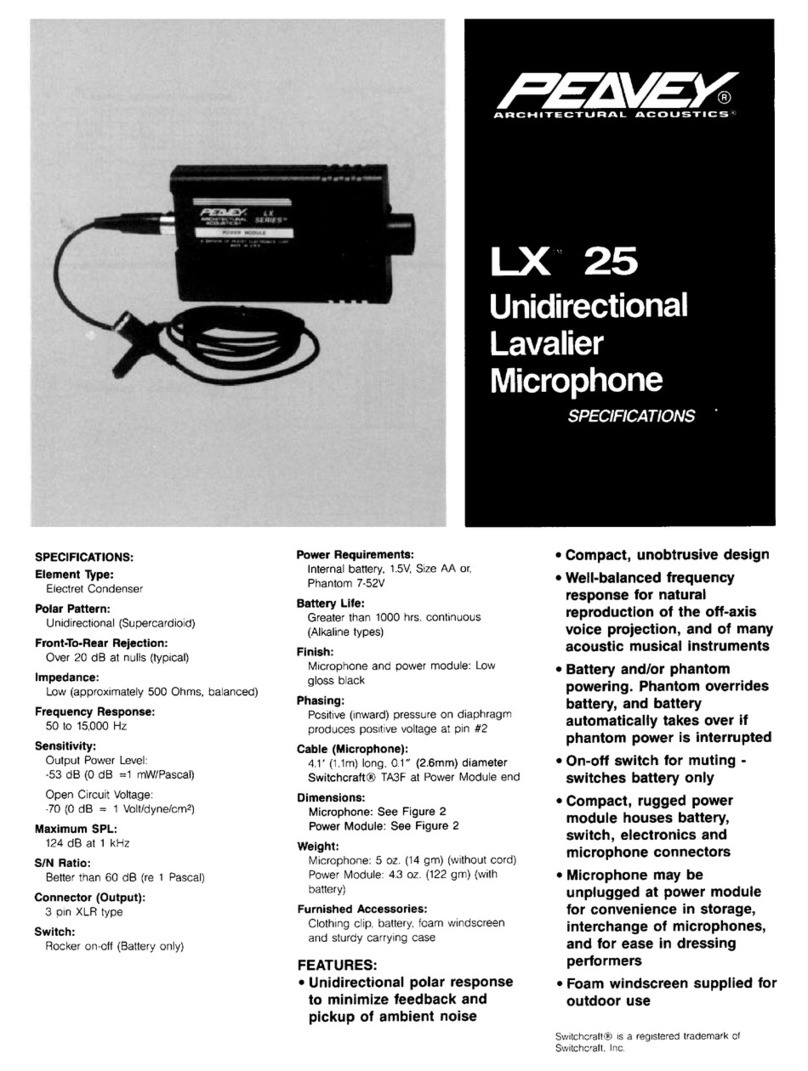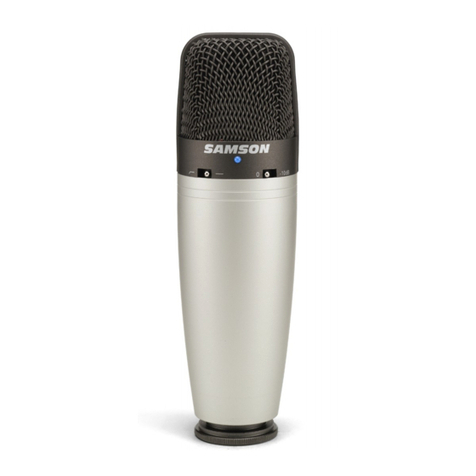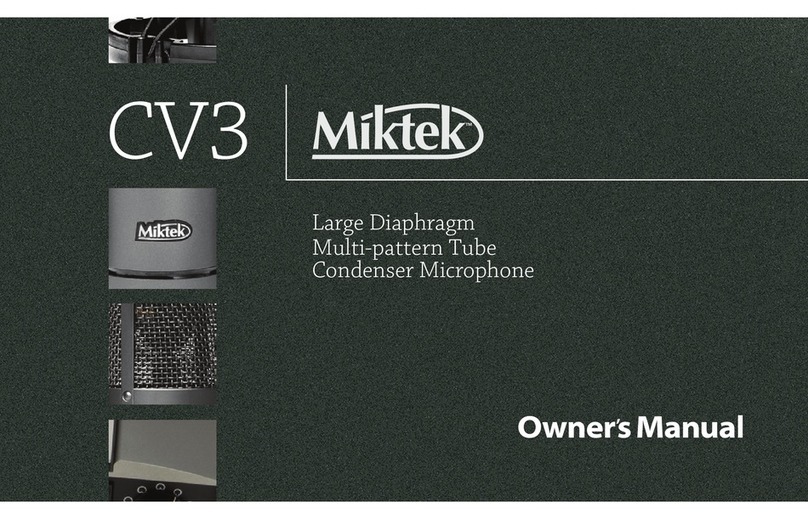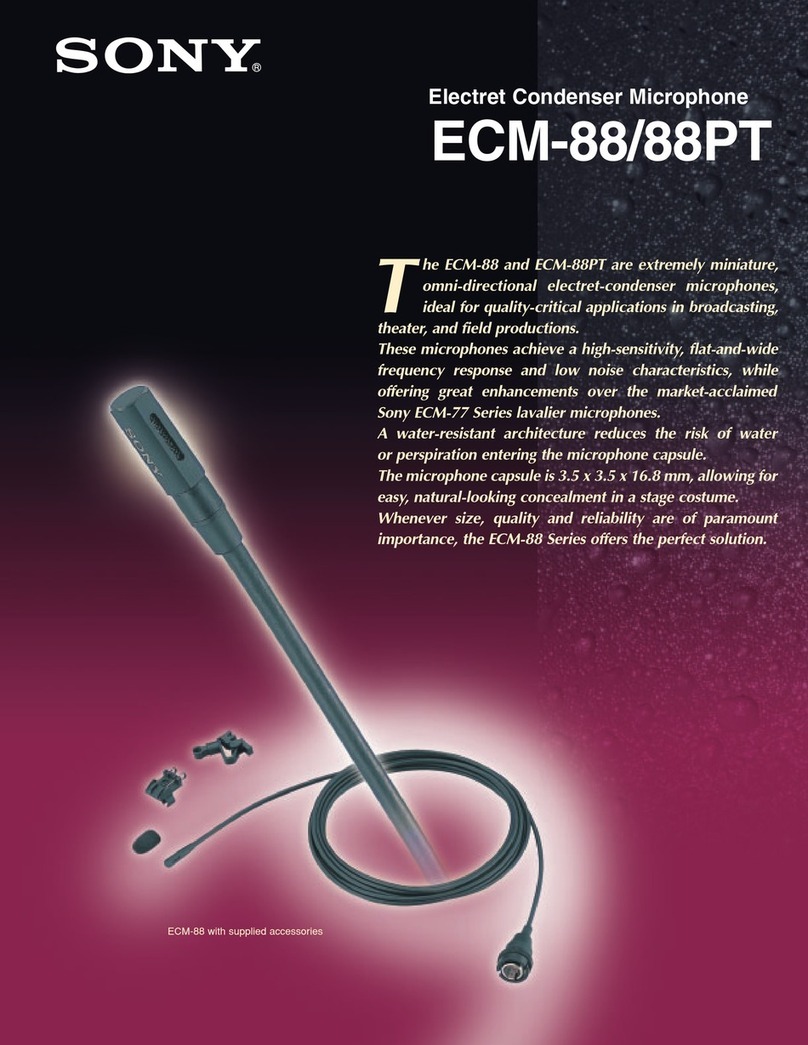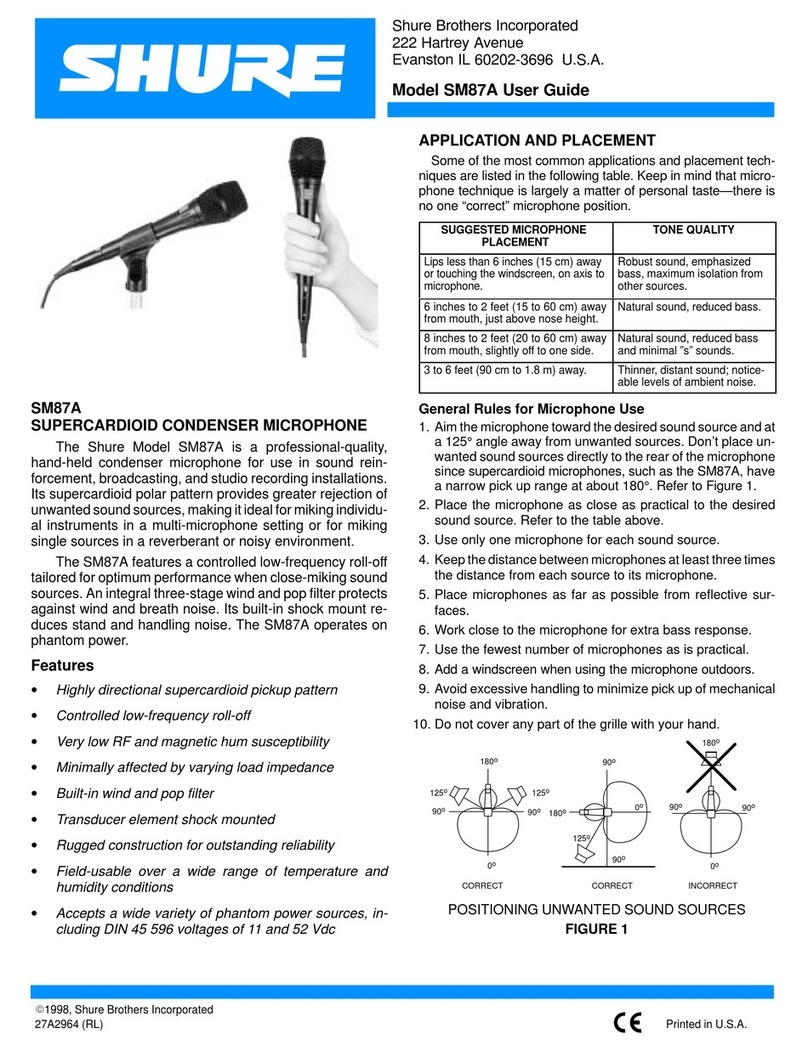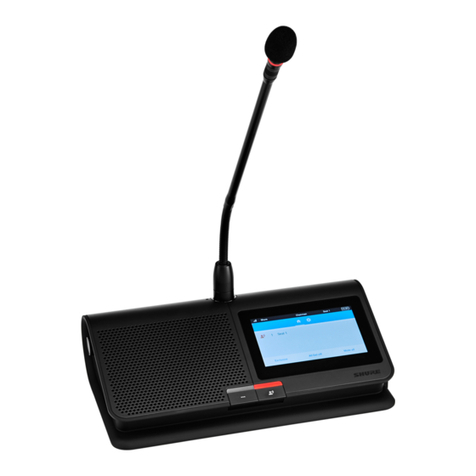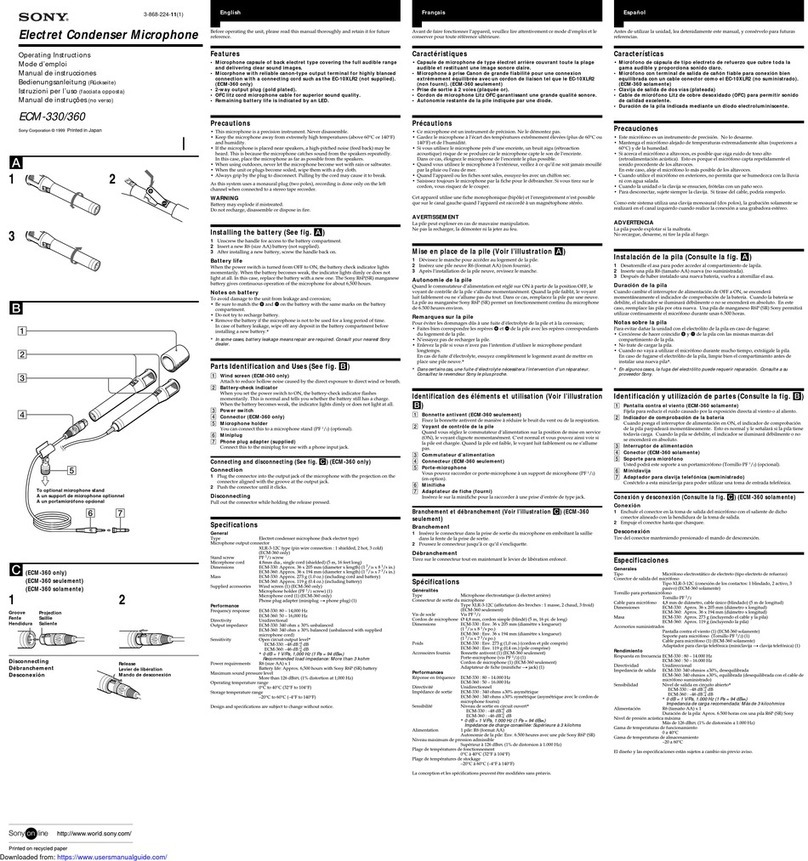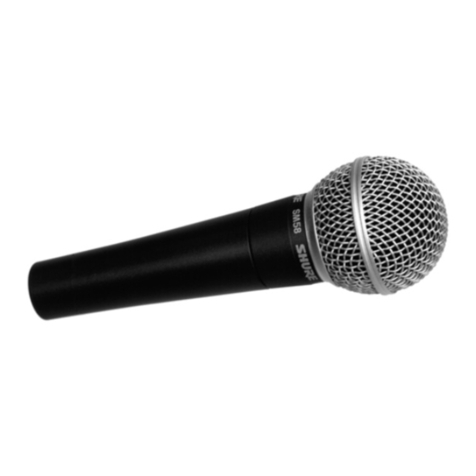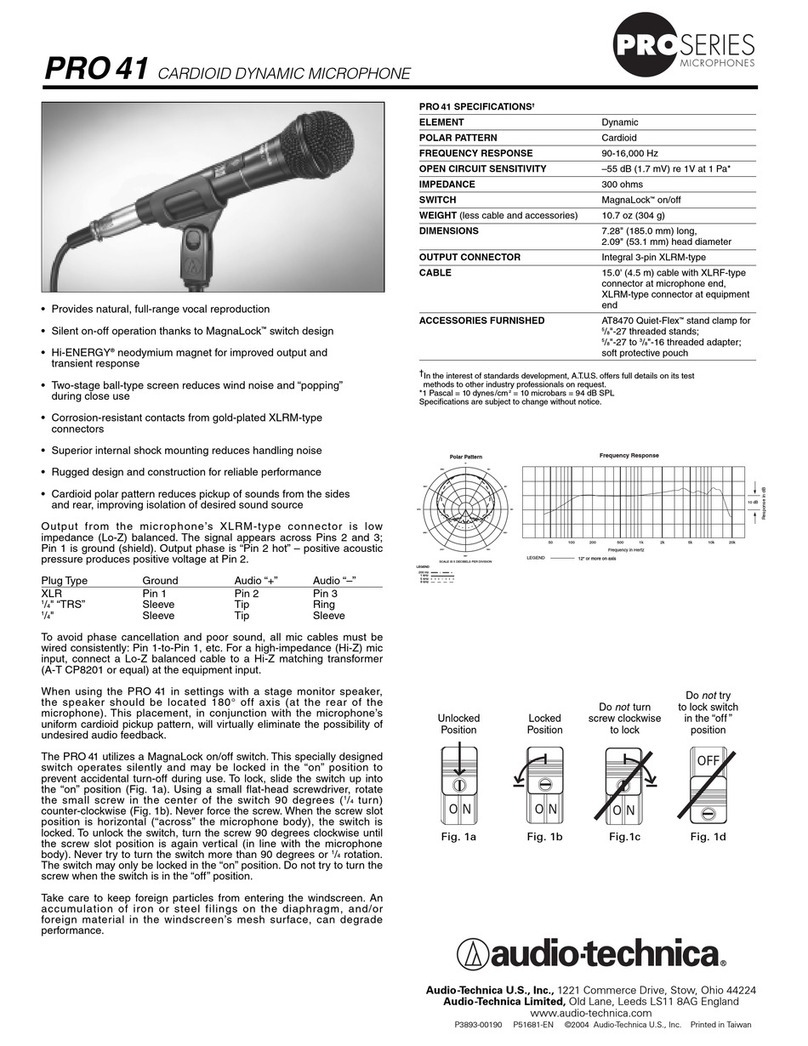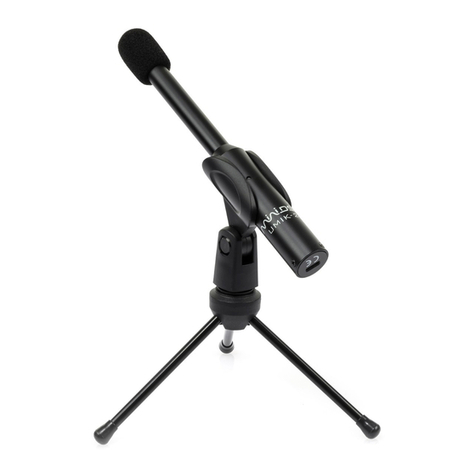Bouyer GM 2800 User manual

Le GM 2800 est un microphone à main,
sans fil, fonctionnant en modulation de
fréquence dans la bande 744 - 764 MHz,
avec un choix parmi 16 fréquences.
Le GM 2800 garantit une constance dans
la qualité de restitution de même qu'une
reproduction chaude de la voix.
Ce microphone s'utilise dans tous les
lieux demandant une grande liberté de
mouvement et une excellente qualité
acoustique (salles de spectacle, stands
de démonstration, salles de con-
férence...).
Le GM 2800 est utilisé avec le récepteur
diversity GZ 2802 (Fig. ).
Le microphone est livré dans une malette
plastique pour le transport et le stockage, et
2 bagues d’identification interchangeables.
• Capsule microphone ...... condensateur
• Bande UHF .................. 744 - 764 MHz
• Bande passante .......... 50 - 16 000 Hz
• Admissibilité .............. 130 dB SPL max
• Synthétiseur de fréquences au pas de
100 kHz
• Stabilité en fréquence ..............0,005%
• Excursion .............................. ± 48 kHz
• Puissance rayonnée ..................10 mW
• Préaccentuation BF......................50 µs
• Portée en champ libre ..........100m max
• Afficheur LCD indiquant :
- la fréquence de travail
- le niveau d’usure des piles
• Réglage de fréquence par touche
• Alimentation ......2 piles alcalines 1,5 V
LR6 AA
• Gamme de tension d’alimentation ..3 V
• Consommation ........................100 mA
• Autonomie :
> 10 heures (Alcalines)
> 8 heures (Accu)
• Température d’utilisation :
-5°C à +55°C
• Température de stockage :
-25°C à +70°C
• Dimensions.................. Ø 57 x 245 mm
• Poids .................. 0,280 kg (avec piles)
• Couleur.......................... gris anthracite
The GM 2800 is a wireless handheld
microphone, operating in the 744 - 764
MHz RF frequencies, with a choice
between 16 channels.
The GM 2800 is warrant of constancy in
the quality restitution and of “warm” voice
reproduction.
The microphone is designed for use in
situations where great freedom of move-
ment together with excellent acoustic quality
are required (theaters, exhibition stands,
conference halls, etc).
The GM 2800 is used with a GZ 2802
receiver (Fig. ).
The microphone is delivered in a plastic
box for his stocking and transportation, and
2 interchangeable identification colour
rings.
• Capsule type ...................... condenser
• UHF range.................... 744 - 764 MHz
• Bandwidth .................... 50 - 16 000 Hz
• Allowable limit .......... 130 dB SPL max
•
Frequency synthesizer in 100 kHz steps
• Frequency stability....................0,005%
• Excursion .............................. ± 48 kHz
• Radiated power ........................10 mW
• Preemphasis ................................50 µs
• Free field ..............................100m max
• Backlight LCD panel :
- channel number
- batteries status
• Channel selector............ digital buttons
• Power supply ..........2 alkaline batteries
(1,5 V LR6 AA)
• Power supply voltage range ............3 V
• Consumption ............................100 mA
• Autonomy :
> 10 hours (Alkaline)
> 8 hours (Rechargeable batteries)
• Room temperature range :
-5°C to +55°C
• Storage temperature :
-25°C to +70°C
• Dimensions.................. Ø 57 x 245 mm
• Weight .......... 0,280 kg (with batteries)
• Colour .......................... anthracite grey
Ce document n'est pas contractuel; toute modification pouvant intervenir sans préavis / This document is not legally binding, we reserve the right to modify descriptions and specifications without notice.
GG
GGMM
MM
22
2288
8800
0000
00
M CROPHONE UHF
UHF W RELESS
M CROPHONE
I - DESCRIPTION I - DESCRIPTION
II - CARACTERISTIQ ES TECHNIQ ES II - TECHNICAL SPECIFICATIONS
GZ 2802 - Récepteur UHF
UHF receiver - GZ 2802
CANAL FREQUENCE (MHz)
CHANNEL FREQUENCY (MHz)
1 744.250
2 745.500
3 746.500
4 747.125
5 748.200
6 749.125
7 750.501
8 753.500
9 754.250
10 755.875
11 757.000
12 758.500
13 759.000
14 760.750
15 761.750
16 763.250
TABLEAU DES FREQUENCES
TABLE OF FREQUENC ES
Fig.
Code 596 305 - 03/12

HF MICRO (Fig. )
1 Condenser cartridge microphone
2Backlight LCD panel (see Fig. V)
3 Batteries compartment (2 x1,5 V LR6 AA)
4dentification colour ring
5On/Off switch
DISPLAYER (Fig. )
6Up channel button
7Dow chanel button
8Set button
9 Channel number display
10 Carrier lock mode
11 Batteries level
FITTING THE BATTERIES (Fig. )
Check that selector switch 5is set to Off. Loosen the microphone
body. Fit 2 x LR6 AA 1,5V alkaline batteries, make sure that the
polarity is correct.
Hold SET button 8(Fig. ) for 3 seconds untill “CH” flashing.
Press 6and 7in order to select the channel.
The range of channel is adjusted from CH1 to CH16.
Press the SET button 8again to store your changes.
After this operation, set the power OFF and then ON again on the
microphone.
NB : Check the GM 2800 microphone is on the same frequency
than the receiver (see frequencies board page 1).
Locking/unlocking
To avoid any inopportune modification of the channel, it is possible
to lock it. Before all new modification of the channel, unlock the
channel:
- Press the SET button 8until the channel blinks.
- Press the SET button again to display locking/unlocking status
- Loc OFF : the channel is unlocking
- Loc ON : the channel is locking
- Press the button 7to lock or 6to unlock
- Press SET button 8to valid the choice.
NB : on locked position, the display indicates Loc ON if ON/OFF
switch is on OFF position.
n order to achieve an optimum reception condition and also extend
the operating distance, leave an “open space” between the
receivver and transmitter.
Keep the devices 50 cm away from the métal objects or any interfer-
ence sources.
To avoid the feedback effect, don’t leave the microphone to aim at
the speakers directly.
Remove batteries from the battery compartment when the transmit-
ter will not be used for a long period of time. Replace both batteris at
the same time.
Don’t expose the microphone to high temperature nor to high
humidity.
Make sure the channels you choose are authorized in your country.
Stock and transport the GM 2800 in his plastic box in order to avoid
the shocks.
This product is subject to European regulation 2002/96/CE
(also called W.E.E.E.).
Please contact your local dealer for destruction in end of life.
This product contains batteries.
Batteries should never be thrown away or incinerated but
disposed in accordance with your local regulations concer-
nin chemical wastes.
When changing the batteries or discording this unit, please
open the product to take the batteries out and dispose of
the batteries in an appropriate place.
III - PRESENTATION
MICRO HF (Fig. )
1Cellule micro condensateur
2Afficheur lumineux (voir détail Fig. V)
3Logement des piles (2 x1,5 V LR6 AA)
4Bague couleur d’identification
5nterrupteur On/Off
AFFICHE R (Fig. )
6Touche incrémentation de fréquence
7Touche décrémentation de fréquence
8 Touche de réglage
9Affichage numéro de canal
10 Verrouillage porteuse
11 Niveau usure piles
MISE EN PLACE DES PILES (Fig. )
Vérifier la position du commutateur 5sur OFF. Dévisser le corps du
microphone. Mettre en place 2 piles alcalines LR6 AA 1,5V en
respectant les polarités.
Appuyer sur la touche SET 8(Fig. ) jusqu’à ce que “CH” clignote.
Ensuite appuyer sur les touches 6et 7pour augmenter ou dimin-
uer le numéro du canal de CH1 à CH16.
Appuyer de nouveau sur la touche 8pour sauvegarder les don-
nées.
Après cette opération, procéder à l’arrêt et au redémarrage du
microphone.
NB : Vérifier que le microphone GM 2800 est bien sur la même
fréquence que le récepteur (voir tableau des fréquences page 1).
Verrouillage/ Déverrouillage du canal
Pour éviter toute modification intempestive de canal, il est possible
de verrouiller ce dernier; toute nouvelle modification de canal devra
alors passer par la phase de déverrouillage :
- Appuyer sur la touche SET
8
jusqu’à ce que le canal clignote.
- Appuyer à nouveau sur la touche SET pour afficher l’état de ver-
rouillage/déverrouillage.
- Loc OFF : le canal est déverrouillé
- Loc ON : le canal est verrouillé
- Appuyer sur la touche
7
pour verrouiller ou
6
pour déverrouiller.
- Appuyer sur la touche SET
8
pour valider le choix.
Remarque : en position verrouillé, l’afficheur indique Loc ON si
l’interrupteur ON/OFF est sur la position OFF.
Afin d’obtenir une condition optimale de réception mais aussi
d’étendre la distance opérationnelle, maintenir un “espace ouvert”
entre les récepteurs et les émetteurs UHF.
nstaller les récepteurs éloignés de tout objet métallique ou d’une
source d’interférence d’au moins 50 cm.
Pour éviter l’effet larsen, n’approcher pas les cellules des micro-
phones trop près des enceintes.
Retirer les piles du microphone quand il n’est pas utilisé pendant
longtemps. Remplacer toujours les piles par paire.
Maintenir l’appareil éloigné des grandes sources de chaleur et des
projections d’eau.
Vérifier que les fréquences soient autorisées dans le pays
d’utilisation du microphone.
Stocker et transporter le GM 2800 dans sa malette plastique afin
d’éviter les risques de chocs.
En fin de vie du produit, s’il est installé sur le territoire
français (DOM-TOM inlus), veuillez contacter BOUYER pour
organiser sa destruction conformément à la directive DEEE.
Dans le cas contraire, veuillez appliquer la règlementation
locale du pays d’installation du produit.
Le GM 2800 contient des piles. Les piles ne doivent en
aucun cas être jetées ou brûlées. Lorsque vous changez les
piles ou en fin de vie du produit, ouvrez celui-ci pour enlever
les piles et déposez les dans un lieu de collecte approprié.
Veillez à respecter la règlementation en vigueur dans le
pays d’utilisation.
III - PRESENTATION
2GM 2800
IV - REGLAGES DES CANA X IV - CHANNEL SETTING
V - RECOMMANDATIONS V - RECOMMENDATIONS
Fig. Fig.
Other Bouyer Microphone manuals
